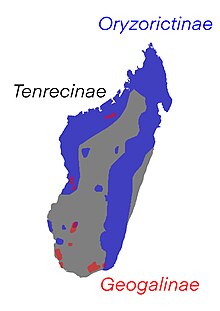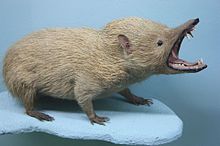| Tenrecidae Temporal range: [1]
| |
|---|---|

| |
| Tailless tenrec (Tenrec ecaudatus) | |
| Scientific classification | |
| Domain: | Eukaryota |
| Kingdom: | Animalia |
| Phylum: | Chordata |
| Class: | Mammalia |
| Order: | Afrosoricida |
| Suborder: | Tenrecomorpha |
| Family: | Tenrecidae Gray, 1821 |
| Type genus | |
| Tenrec Lacépède, 1799
| |
| Subfamilies | |

| |
| Gray: Tenrecinae ; Blue: Tenrecinae and Oryzorictinae ; Red: Geogalinae and Tenrecinae ; Purple: Geogalinae , Oryzorictinae and Tenrecinae | |

A tenrec (/ˈtɛnrɛk/) is a mammal belonging to any species within the afrotherian family Tenrecidae, which is endemic to Madagascar.[2] Tenrecs are a very diverse group; as a result of convergent evolution,[3] some resemble hedgehogs, shrews, opossums, rats, and mice. They occupy aquatic, arboreal, terrestrial, and fossorial environments. Some of these species, including the greater hedgehog tenrec, can be found in the Madagascar dry deciduous forests. However, the speciation rate in this group has been higher in humid forests.[4]
All tenrecs are believed to descend from a common ancestor that lived 29–37 million years ago[4][5][6] after rafting over from Africa.[7][8] The split from their closest relatives, African otter shrews, is estimated to have occurred about 47–53 million years ago.[4][5][6]
- ^ Pickford, Martin (2015). "Late Eocene Potamogalidae and Tenrecidae (Mammalia) from the Sperrgebiet, Namibia" (PDF). Communications of the Geological Survey of Namibia. 16: 114–152.
- ^ Olson, Link E. (2013). "Tenrecs". Current Biology. 23 (1): R5–R8. Bibcode:2013CBio...23...R5O. doi:10.1016/j.cub.2012.11.015. PMID 23305671.
- ^ Olson, Link E. (2013). "Tenrecs". Current Biology. 23 (1): R5–R8. Bibcode:2013CBio...23...R5O. doi:10.1016/j.cub.2012.11.015. PMID 23305671.
- ^ a b c Everson, K. M.; Soarimalala, V.; Goodman, S. M.; Olson, L. E. (2016). "Multiple Loci and Complete Taxonomic Sampling Resolve the Phylogeny and Biogeographic History of Tenrecs (Mammalia: Tenrecidae) and Reveal Higher Speciation Rates in Madagascar's Humid Forests". Systematic Biology. 65 (5): 890–909. doi:10.1093/sysbio/syw034. PMID 27103169.
- ^ a b Douady, C. J.; Catzeflis, F.; Kao, D. J.; Springer, M. S.; Stanhope, M. J. (2002). "Molecular Evidence for the Monophyly of Tenrecidae (Mammalia) and the Timing of the Colonization of Madagascar by Malagasy Tenrecs". Molecular Phylogenetics and Evolution. 22 (3): 357–363. Bibcode:2002MolPE..22..357D. doi:10.1006/mpev.2001.1055. PMID 11884160.
- ^ a b Poux, C.; Madsen, O.; Glos, J.; de Jong, W. W.; Vences, M. (2008). "Molecular phylogeny and divergence times of Malagasy tenrecs: Influence of data partitioning and taxon sampling on dating analyses". BMC Evolutionary Biology. 8 (1): 102. Bibcode:2008BMCEE...8..102P. doi:10.1186/1471-2148-8-102. PMC 2330147. PMID 18377639.
- ^ Kinver, M. (2010-01-20). "Mammals 'floated to Madagascar'". BBC News web site. BBC. Retrieved 2010-01-20.
- ^ Ali, J. R.; Huber, M. (2010-01-20). "Mammalian biodiversity on Madagascar controlled by ocean currents". Nature. 463 (4 Feb. 2010): 653–656. Bibcode:2010Natur.463..653A. doi:10.1038/nature08706. PMID 20090678. S2CID 4333977.